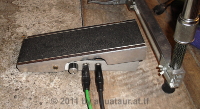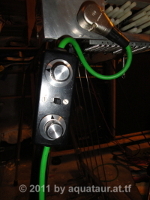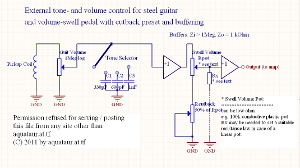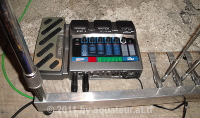|
Volume
Pedals And Steel Guitars Getting tone right for the steel guitar last update: April 18, 2021 Copyright 2011-25 by
H. Gragger. All Rights Reserved. All information
provided herein is destined for educational and
D.I.Y. purposes only. Commercial re-sale,
distribution or usage of artwork without explicit
written permission of the author is strictly
prohibited.The original units with their
associated trade-names are subject to the
copyright of the individual copyright owner. The
Author is by no means affiliated with any of those
companies. References to trade names are made for
educational purposes only. By reading the
information provided here you agree to the Terms
of
Use. The working language
is kept in English as an aid. Read here
why.
|
||||||
| MAIN PAGE>MUSIC STUFF>STEEL_VOLUME Index   Darn Country Music Darn Country Music  Pumpinī The Volume Pumpinī The Volume  I Fought The Law
And I Won I Fought The Law
And I Won  More On Pots More On Pots  Going Digital Going Digital  Darn Country
Music Darn Country
MusicNote: recent follow up article Multi-FX Device Used As Fancy Volume Pedal For Steel Guitar Country Music has been floating in and out of my life. Some times I darn love country, then again I canīt hear darn country. Currently itīs loving time. (Apart from that - the steel is not limited to country music...)
However, out with the
old pedal steel and the steel bar and the picks and
the ole volume pedal.
A volume pedal is crucial to the steel guitar, it lends a very dynamic and soulful expression to its tone. Unfortunately most pedals sold for the job are not fit for it, so letīs look how we can improve on the situation. Back To Index Pumpinī The Volume Volume pedals
for steel guitars are used extensively. The volume
pedal gets permanently pumped, much more than say,
a wah pedal; this would only be used with
discretion occasionally.
I guess that 50% of the pedals around are of simple mechanical type using a potentiometer as variable element, the rest will be mostly optoelectronic. The latter had accumulated a bad reputation in the past, because early specimens were tone suckers besides having an awkward range and being current eaters. So for the steel, most pedals are mechanical ones. Incidentally, this will be the pedal a typical specialized steel guitar dealer will stock by tradition. A potentiometer gets fairly abused in this application, so early failure is preprogrammed and regular pot change inevitable. As with other pedals, a war has ensued, which pot law gives the smoothest volume control for the steel. Now the point is not to cut the signal off, this is rarely desired. This sounds awful and amateur. The point is to give some "breath" and sustain to the signal, to hide the attack and make the signal appear to sustain at a rate and magnitude that is entirely up to the players personal intonation and taste. Mastering the volume pedal becomes a two-fold task, namely pumping permanently during playing by a process that is mainly automatized and keeping the pedal throw (and thus the volume cut back) even. Unfortunately, the latter is entangled with the pedal type you use, the pot law you use (which may change once you replace a worn out one) and, curiously, even with the type of shoes you wear. Flat shoes compared to the ubiquitous country boots do position your foot slightly different under the steel, which may make an entirely different pivot point for rocking your foot. Since some positions are not comfortable for the foot (where the toes are risen) this determines your amount of cut-back. Back To Index I Fought The Law And I Won So different logarithmic pot laws may not provide the solution we are seeking for. It dawned on me when I recalled seeing a training video of a steel player:
A mechanical
stop thus could provide some relief, but may be
clumsy.
A current volume pedal maker has a seemingly digital pedal that allows to dial in several pot laws, but this may be of little use, not to mention the price tag. Also, for a steel the pedal should be rather slim to avoid raising the knee (and therefore the playing height) too high to maintain an ergonomical playing position, so not all pedals will do. I am pretty tall so I had to use a Goodrich lowboy model (L-120). The Boss FV-50 volume pedal has a separate pot that adds some resistance to the ground side and therefore limit the maximum attenuation you can achieve with a full pedal travel to a preset level. This "stretches" the law of the potentiometer over a bigger mechanical travel so to speak. That is exactly what we need. Unfortunately, the Boss units will not withstand the rigours of steel guitar usage, so letīs make a homebrew solution. The Goodrich unit has two output jacks in parallel (maybe for a stereo option using the same housing). I removed one and installed a linear pot instead. This is wired in series with the ground leg of the pedalīs volume pot and thus adjusts the maximum attenuation you can achieve. I used a 10k pot for the volume action (read later on why using such a low value is possible...) and a 5k for the cutback which results in a 2:1 ratio.  Playing with a pedal like this is a breeze compared to the on-off playing I had before. It does exactly what one would expect and frees you from one burden while trying to coordinate your picking, muting, bar muting, foot pedals, knee levers and whatever. And you can alter the level of cutback at the twist of a knob. Back To Index More On Pots But this is not the end of the list of improvements. One more aspect
we must not forget is impedance. Most steel guitar
volume pedals sold have 500k input impedance,
which in parallel with some ampīs or effectīs
input and together with alleged cable capacity is
way too low to preserve tone. This is
noticeable, you lose the sparkle and liveliness of
tone. Steel players are nit-picky about their
tone, so the first thing they get is either an
active pedal or a separate impedance converter box
in front of it (the lowboy model was not available
with a buffer when I bought it, so I installed my
own...)
Also, a 500k source as the pot will be does not exhibit breath-taking drive characteristics as well, so an additional driver after the pot would not hurt. Using a low-current buffer will preserve battery power for a long time even for two buffers. The pot now becomes an effects device with proper input impedance and drive characteristics. Buffering the input of the pedal removes a lot of restrictions on pot selection we have otherwise. We can use about any pot impedance we like. I used conductive plastic pots with success. Being normally used as rotary position indicators (that have not end-stops), they are fit for 10 million revolutions before they fail, which is a factor of 100 bigger than but the best carbon pots. They only come with a linear law, but this can be changed with the addition of a simple resistor as shown in the secret life of pots. Since most conductive plastic pots do not have end-stops, they just roll over from min to max with a dead zone in between. This results in a bigger usable electrical rotational angle. Using a pot like for its full range may therefore require a different (smaller diameter) bobbin for rolling up the thread that usually creates the pot angle displacement on such devices. It was a simple milling job done by a friend in a short time. As usual, I advocate installing a buffer or a dedicated external box they sell for the purpose. If a very low impedance pot (resulting 20k or so) is used, an output driver (buffer) may be overkill and thus may be omitted. On the steel I have (a Sho-Bud universal), no controls are installed on the guitar itself (such as volume and tone). This sometimes is unpractial. I made myself a little passive external box that clips onto the leg of the steel containing a 1Meg log pot for volume (a load for the pickup which is inaudible) plus a series of small caps with increasing value on a rotary switch such as I have used it in my strat modification. This works well and preserves tone quality, but only in conjunction with a subsequent buffer of high enough input impedance.   Note: This type of tone control places a small capacity (in the range of up to some nF) in parallel with the pickup, which creates a resonant circuit with high Q, sort of a narrow band mid boost. A small resistor in series can dampen this effect if desired. I now have pristine tone, volume and tone knobs on the guitar and a buffered pedal with a maximum cutback control. Country Heaven, here I come! Back To Index Going Digital The digital
guitar processor I have (RP-500) has a similar
maximum cutback feature by setting a minimum value
on the volume pedal when full back. This does
exactly the same thing, although the pedal
certainly has a different throw and overall feel
than, say a Goodrich.
While the RP-500 is certainly too big to fit under a steel guitar, the RP-350 may just fit (for 3 pedal E9 steels at least). However, their smaller brothers like the RP-255 will certainly fit, while having the same engine under their hood. They all share the same basic features needed: diverse reverbs of superb quality and diverse delay types (not much can be worse than a small Boss delay stompbox).  Serious pedalling folks! I had good results with selecting a vintage type amp simulation (which were, for all practical means, low gain and linear) and some 4x12 speaker simulation which should provide enough low end (N.B: selecting "direct" instead of speaker simulation certainly will provide tons of low end if you are not into recording). Mid scoops and boosts can be dialled in ad lib. The Digitechīs input impedance is with 500kOhms not overwhelming, but wonīt do any more damage to tone than a volume pot smaller than 1 Meg in your steel. I would, nevertheless, spend a buffer box. So for a player on a budget, this may be the way to go. You get your delay, reverb, amp, speaker simulation, recording interface and volume pedal all in one box for a price that normally the volume pedal alone costs. And you see - less cables too. Back To Index Update History
MAIN PAGE>MUSIC STUFF>STEEL_VOLUME |
||||||
MAIN PAGE | MUSIC STUFF | IMPRESSUM  (c) 2011-25 AQUATAUR Musik & Elektronik |